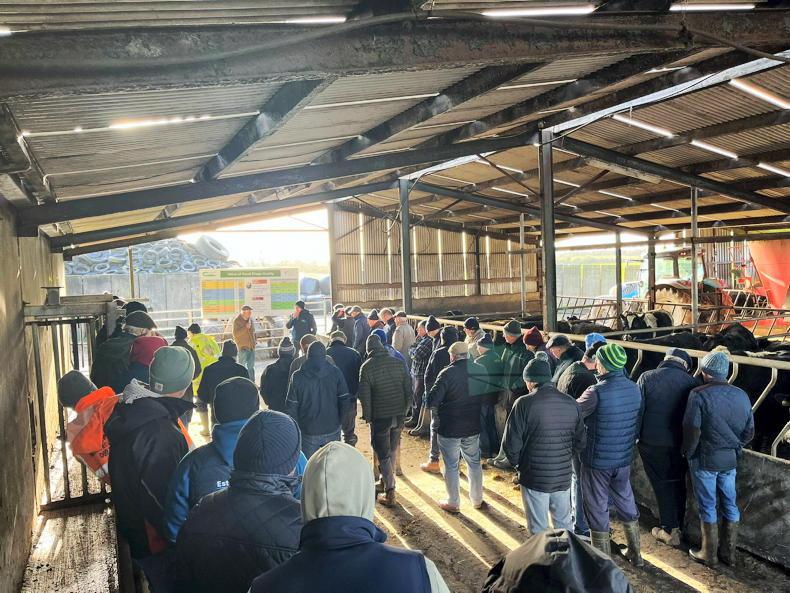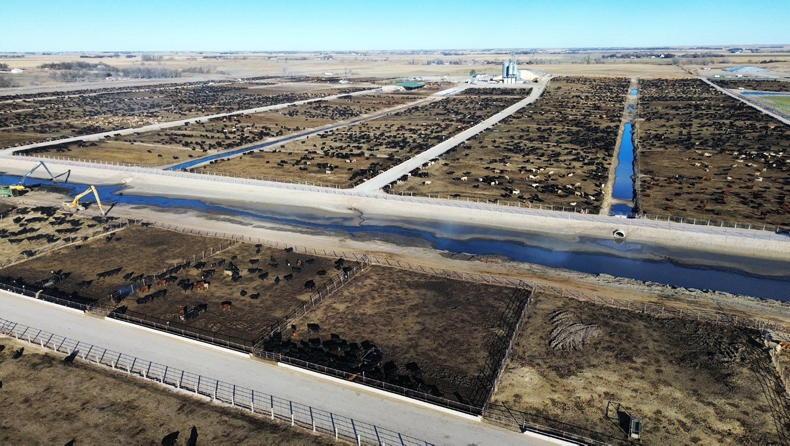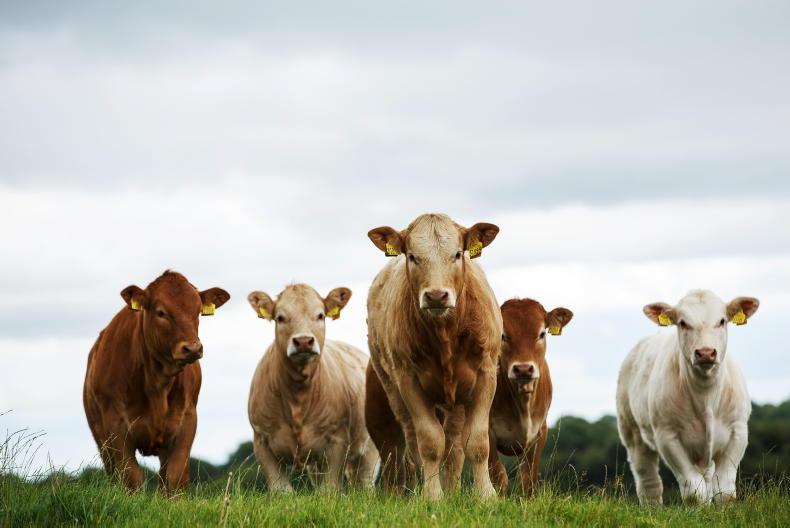Dairy beef continues to grow in popularity on farms, with a lot of suckler farms now rearing some dairy beef calves as an additional enterprise.
As with any cattle finishing system, margins are extremely tight in dairy beef systems, with no room for error.
If anything, there is less room for error in terms of hitting weight targets at grass during the first and second grazing seasons when compared to suckler systems.
In a lot of cases, reduced liveweight gain at grass will mean increased days in the shed during the second winter at high daily feed costs.
Weaning
Calves can be weaned anytime from eight weeks onwards. In general, dairy beef calves will be weaned between eight and 12 weeks of age depending on weight gains and concentrate intake.
Calves should be eating at least 1kg of concentrates consecutively over four to five days before weaning. Calves should also be healthy before weaning takes place. Any stressors like disbudding or castration should be avoided around weaning time.
A starter concentrate should be made available to calves from two weeks of age, with intakes increasing up to 0.5kg/day at five weeks.
This should reach 1kg/day at eight weeks of age. Weaning calves earlier or before they are eating enough concentrates on a daily basis can result in a growth check.
High intakes of bulky hay or silage can also lead to stunted calves. Lost weight gain at this stage in the calf’s life won’t be made up again without a longer finishing time at the other end.
To feed or not to feed at grass
There is debate around continuing to feed calves at pasture for the first grazing season. My experience is that calves should be fed 1kg/head a day at grass.
Weanling crunch is currently coming in at €350-370/t and will come down further in the months ahead.
At this price, feeding 1kg/head a day will cost around 35-37c/head each day.
If the calf is at grass from 1 June until 1 November, you’re looking at a cost of €55/head. While dairy beef margins are very tight and every cost needs to be looked at and analysed, high animal performance is critical to meeting any profitability targets.
The impact of losing 20-30kg of weight gain over the first grazing season will have implications on finishing date, and feeding an animal indoors on a silage and meal diet at the end of the second grazing season will cost close to 10 times the cost of the 1kg of meal during the first grazing season.

My experience is that calves should be fed 1kg/head a day at grass.
If grassland management is very good and calves are being grazed in a paddock system, you may be able to take out the concentrates.
On some dairy beef farms, feeding concentrates is used as a management tool. If calves come to the trough to feed, you know they are healthy.
Summer
scour syndrome
Summer scour syndrome has become more prevalent in recent years on some farms. The scour presents itself in calves that have been turned out on good grazing swards full of lush, green grass.
The scour tends to be watery and green in colour and calves that get it start scouring. Calves don’t respond to routine treatments for worms or coccidiosis, and some can die if very dehydrated and left too long without fluids.
Calves generally have an underdeveloped immature rumen, so small changes to the diet can have a big effect on the digestive system.
Young calves are quite selective grazers and will tend to seek out the leafiest part of a sward, which can sometimes be high in nitrogen. This leafy grass is also low in fibre, so the combination leads to scour and weight loss.

In general, dairy beef calves will be weaned between eight and 12 weeks of age depending on weight gains and concentrate intake.
If you suspect that your calves are suffering from summer scour syndrome, the first call should be with your vet to discuss treatment options.
Treatment is pretty similar to the treatment for standard scours, and rehydration with electrolytes is important for very sick calves.
Ideally, calves should be removed from the grass they started the scouring on; housed and fed forage, such as hay, silage or straw. They should be fed concentrates while indoors.
As with other scours, summer scour syndrome can cause stress on the calf and lead to the onset of other complications like pneumonia.
In terms of prevention, getting the weaning process right is critical. A gradual weaning process is best – with a gradual reduction of milk intake over a period of four weeks.
Calves should be eating at least 1kg of concentrate/day over a consecutive number of days at the point of weaning.
For the first few weeks at pasture, try to give calves access to some pasture with stem or older swards to increase the fibre content of their diet. Strip grazing can also make calves eat out some of the sward with stem material.
Weaning should take place between eight and 12 weeks of age.Calves should be consuming 1kg of concentrates/day before being weaned.Concentrates being fed to calves should be highly palatable.Avoid very lush, leafy grass in the first month after turnout.Calves should continue to be fed 1kg of concentrates/day at grass, unless grassland management is very good.Include some long fibre (stemmy grass) in the calf’s diet to avoid summer scour syndrome.
Dairy beef continues to grow in popularity on farms, with a lot of suckler farms now rearing some dairy beef calves as an additional enterprise.
As with any cattle finishing system, margins are extremely tight in dairy beef systems, with no room for error.
If anything, there is less room for error in terms of hitting weight targets at grass during the first and second grazing seasons when compared to suckler systems.
In a lot of cases, reduced liveweight gain at grass will mean increased days in the shed during the second winter at high daily feed costs.
Weaning
Calves can be weaned anytime from eight weeks onwards. In general, dairy beef calves will be weaned between eight and 12 weeks of age depending on weight gains and concentrate intake.
Calves should be eating at least 1kg of concentrates consecutively over four to five days before weaning. Calves should also be healthy before weaning takes place. Any stressors like disbudding or castration should be avoided around weaning time.
A starter concentrate should be made available to calves from two weeks of age, with intakes increasing up to 0.5kg/day at five weeks.
This should reach 1kg/day at eight weeks of age. Weaning calves earlier or before they are eating enough concentrates on a daily basis can result in a growth check.
High intakes of bulky hay or silage can also lead to stunted calves. Lost weight gain at this stage in the calf’s life won’t be made up again without a longer finishing time at the other end.
To feed or not to feed at grass
There is debate around continuing to feed calves at pasture for the first grazing season. My experience is that calves should be fed 1kg/head a day at grass.
Weanling crunch is currently coming in at €350-370/t and will come down further in the months ahead.
At this price, feeding 1kg/head a day will cost around 35-37c/head each day.
If the calf is at grass from 1 June until 1 November, you’re looking at a cost of €55/head. While dairy beef margins are very tight and every cost needs to be looked at and analysed, high animal performance is critical to meeting any profitability targets.
The impact of losing 20-30kg of weight gain over the first grazing season will have implications on finishing date, and feeding an animal indoors on a silage and meal diet at the end of the second grazing season will cost close to 10 times the cost of the 1kg of meal during the first grazing season.

My experience is that calves should be fed 1kg/head a day at grass.
If grassland management is very good and calves are being grazed in a paddock system, you may be able to take out the concentrates.
On some dairy beef farms, feeding concentrates is used as a management tool. If calves come to the trough to feed, you know they are healthy.
Summer
scour syndrome
Summer scour syndrome has become more prevalent in recent years on some farms. The scour presents itself in calves that have been turned out on good grazing swards full of lush, green grass.
The scour tends to be watery and green in colour and calves that get it start scouring. Calves don’t respond to routine treatments for worms or coccidiosis, and some can die if very dehydrated and left too long without fluids.
Calves generally have an underdeveloped immature rumen, so small changes to the diet can have a big effect on the digestive system.
Young calves are quite selective grazers and will tend to seek out the leafiest part of a sward, which can sometimes be high in nitrogen. This leafy grass is also low in fibre, so the combination leads to scour and weight loss.

In general, dairy beef calves will be weaned between eight and 12 weeks of age depending on weight gains and concentrate intake.
If you suspect that your calves are suffering from summer scour syndrome, the first call should be with your vet to discuss treatment options.
Treatment is pretty similar to the treatment for standard scours, and rehydration with electrolytes is important for very sick calves.
Ideally, calves should be removed from the grass they started the scouring on; housed and fed forage, such as hay, silage or straw. They should be fed concentrates while indoors.
As with other scours, summer scour syndrome can cause stress on the calf and lead to the onset of other complications like pneumonia.
In terms of prevention, getting the weaning process right is critical. A gradual weaning process is best – with a gradual reduction of milk intake over a period of four weeks.
Calves should be eating at least 1kg of concentrate/day over a consecutive number of days at the point of weaning.
For the first few weeks at pasture, try to give calves access to some pasture with stem or older swards to increase the fibre content of their diet. Strip grazing can also make calves eat out some of the sward with stem material.
Weaning should take place between eight and 12 weeks of age.Calves should be consuming 1kg of concentrates/day before being weaned.Concentrates being fed to calves should be highly palatable.Avoid very lush, leafy grass in the first month after turnout.Calves should continue to be fed 1kg of concentrates/day at grass, unless grassland management is very good.Include some long fibre (stemmy grass) in the calf’s diet to avoid summer scour syndrome. 











SHARING OPTIONS